|
Messerschmitt Bf 110 C

Eduard, 1/48 scale
S
u m m a r y
|
| Catalogue Number: |
Eduard Kit No. 8201 - Messerschmitt
Bf 110 C |
| Scale: |
1/48 |
| Contents and Media: |
207 parts on six sprues in grey coloured plastic;
12 parts in clear; colour photo-etched fret; brass photo-etched fret; self-adhesive die-cut masking sheet; markings for
five aircraft. |
| Price: |
USD$54.95 plus shipping online from Eduard
|
| Review Type: |
FirstLook |
| Advantages: |
Well detailed; lovely surface
features including crisply recessed panels and subtle rivet lines where
appropriate; includes colour photo-etched parts for harnesses and
instrument panel; alternate photo-etched consoles and panels in RLM 02 and
RLM 66; separate canopy parts for closed/open cockpit and rear
clamshell; attractive marking options; very high quality
plastic; narrow sprue attachments. |
| Disadvantages: |
Wheels appear more appropriate for
Bf 110 E; fixed control surfaces; some fit challenges - experience will be helpful. |
| Recommendation: |
Even after 15 years this is a nicely presented and detailed kit. The high parts count and some of the smaller and delicate parts mean that modelling experience will be helpful before tackling this project. Having built the Bf 110 E kit, I can advise that it is worth the effort. It looks as good when it is finished as it does in the box! |
Reviewed by Brett Green

The Messerschmitt Bf 110 entered the Second World War as a new and
prestigious weapon of the Luftwaffe, performing the roles of
bomber escort, heavy fighter and troop support during the German
invasion of Poland. It performed well against Polish fighters, and put
its heavy armament to effective use against ground targets after the
Luftwaffe had established air superiority. The Bf 110 repeated these
roles during the campaign in the West. The long range of the Bf 110 was
especially useful for escorting bombers deep into France.
The twin engine Messerschmitt was more than a match for most
contemporary French fighters, but early encounters with Spitfires and
Hurricanes resulted in unaccustomedly heavy losses. This was an ominous
indicator of the coming months over the British Isles.
In those Summer months of 1940, Messerschmitt Bf 110s on long-range
escort missions suffered heavy losses to British fighters. Eventually,
Messerschmitt Bf 110s had to be escorted themselves by the more nimble
Bf 109s.
Even if its fortunes as a pure fighter aircraft were mixed, the
Messerschmitt Bf 110 had a better record as a defensive weapon.
As early as December 1939, Bf 110 C aircraft of I./ZG 76 were
involved in the decimation of an armed reconnaissance patrol over the
Heligoland Bight. Eight Wellingtons out of a total 22 on patrol were
claimed by the Zerstörers. This single event put massed daylight
bombing off the agenda until 1943, but ZG 2 and ZG 76 continued to enjoy
superiority over Blenheims and Wellingtons in the following months.
Arguably the most important contribution made to the German war
effort by the Messerschmitt Bf 110 was as a night fighter. The role was
initially ad-hoc. From July, 1940, day fighters were simply painted
black and sent aloft to deal with British bombers, now making their
attacks under the relative protection of darkness. These early night
fighters had no additional equipment nor ground control assistance.
Enemy aircraft were held in the cone of a searchlight, and the Bf 110
would engage the bomber while it was illuminated in the beam.
Eduard launched their Bf 110 series with the E variant back in September 2007.
Over more than a decade they followed up with the version most commonly
associated with the Bf 110 C, C-6, D, E, F, F-4, G-2 and G-4.
Eduard is now offering a reboxed Bf 110 C in its ProfiPACK family. This means that, in addition to the plastic sprues, you'll get colour and brass photo-etched parts and masks.
Not surprisingly, most of the parts in this
reissue are common with the earlier releases. The main differences are the marking options and, of
course, no resin dachshunds!
Eduard's 1/48 scale
Messerschmitt Bf 110 C comprises 207 parts in grey coloured plastic; 12 parts in clear; one colour photo-etched fret and another fret in bare brass; a masking sheet
and markings for five aircraft.
This release continues Eduard's long tradition of world
class quality
injection moulded parts, remarkable detail and colorful markings.
The plastic parts are attached to six sprues via fine connectors.
Moulding quality is flawless. I could not find a single sink mark or
ejector pin in any area that will be visible on the finished model.
Crisply recessed panel lines are partnered with incredibly subtle rows
of rivets. I like the treatment of the fabric control surfaces too, with
rib tape detail being the most prominent feature - no massive sagging of
fabric.

The fuselage is broken down into the main halves with a separate nose
(upper and lower) plus an insert for the deck immediately aft of the
cockpit. The tail is moulded as a single piece. In addition to the Bf 110 C/D nose, Eduard also supplies the E
nose (easily distinguished by the rectangular intake).
One nice touch in this kit is
the provision of alternate photo-etched consoles and panels - one set in RLM
02 and another in RLM 66. The choice is yours (after consulting
references of course).
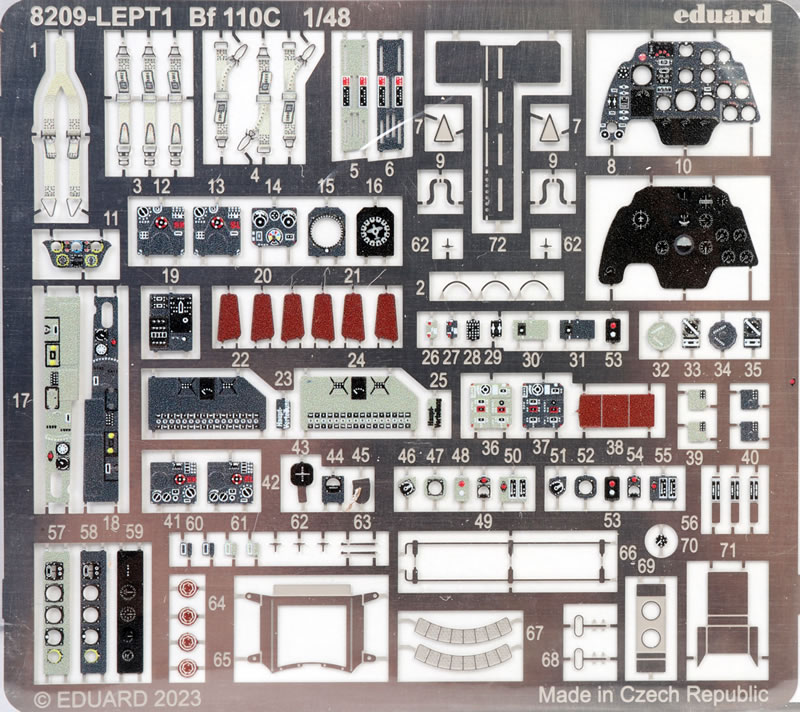
An alternative plastic instrument panel is on the sprues too.
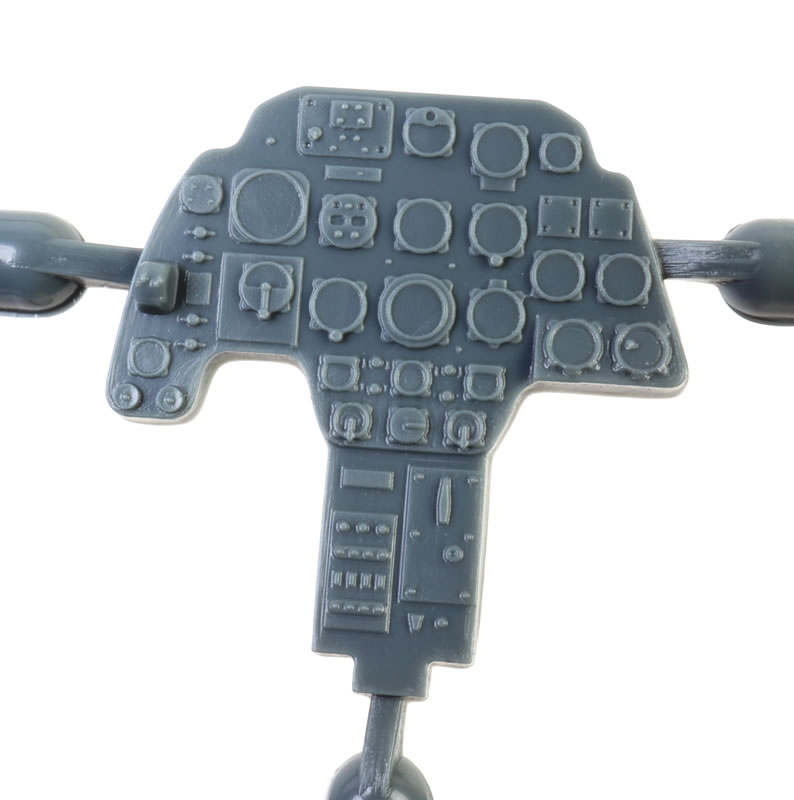
The brass photo-etched fret provides parts mainly for the exterior of the model.

The lower fuselage cannon are
visible through the fuselage floor, and plenty of spare ammunition is
provided. The rear gunner's seat can be made to swivel, while the
navigator's seat may be posed up or stowed.
The nose is fully equipped with four MG 17 machine guns and
ammunition feeds plus oxygen bottles. These may be displayed by posing
the separate gun cowl open.
The wings are moulded with the flaps and leading edge
slats in the closed position. This may disappoint some modellers, but I
did a quick check of several books and nearly half of the Bf 110s were
parked with the slats and flaps up. If you really want to drop the flaps
and/or slats, the kit engineering will make this task fairly
straightforward with the bulges behind the nacelles moulded as part of
the bottom of the kit flaps.
Ailerons are provided as separate parts.
Wheel well detail is excellent.
The engine nacelles are supplied separate from the
wings allowing for different variants.
The shape of the spinners looks good, and the prominent pitch collars
are moulded near the base of each propeller blade. These should be
clearly visible when the propeller assembly is complete. The main wheels
do seem to be the same as those included in Eduard's Bf 110 E kit, but
reference photos suggest that the hubs should be smaller for the Bf 110
C. A number of aftermarket options are available now.
Two sprues of clear parts are included. The prominent
glasshouse is an important part of the Bf 110's character, and Eduard
has done an especially good job on the complex rear clamshell. If the
rear canopy is to be depicted open, separate parts are supplied for the
clamshell and the sliding top rear sections. If the canopy will be
closed, a totally separate single part is used. A separate piece of
armoured glass is also depicted, with an alternate photo-etched frame if
the modeller prefers.
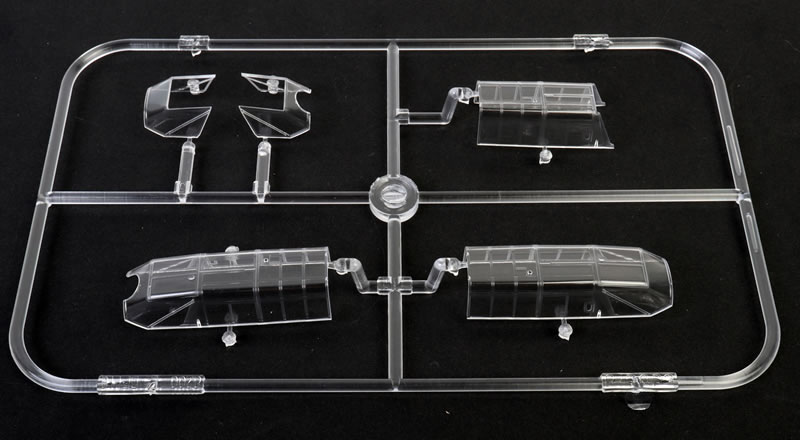
The side and top canopy parts are also individual
pieces to permit posing in the open position. Furthermore, alternate
styles of rear canopy are offered - with the machine gun cutout and
without. Handles and other canopy details are supplied in both photo
etch and plastic. Eduard masks are also included to ease the pain of
painting that maze of canopy frames.
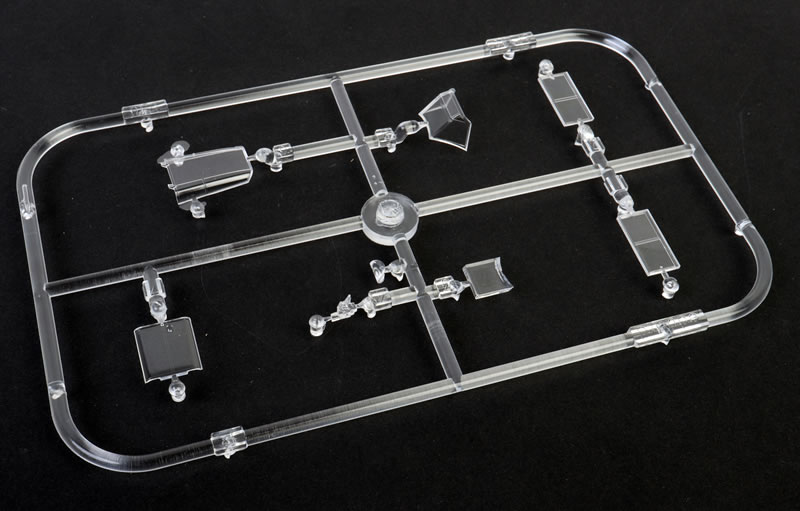
Instructions are supplied in a colour 20 page booklet,
with a historical summary on the front page followed by a parts list, 13 pages of construction steps and four pages of full-colour marking
guides, each with a four-view illustration plus scrap views. The schemes
reflect the evolution of Bf 110 camouflage from mid-1940, with RLM 70/71
schemes of the Battle of France and early Battle of Britain; moving to
the paler finish of RLM 02 and RLM 71 with soft mottled fuselage sides
also in the Battle of Britain; and even an interesting night fighetr
seeing service in North Africa during summer 1941.
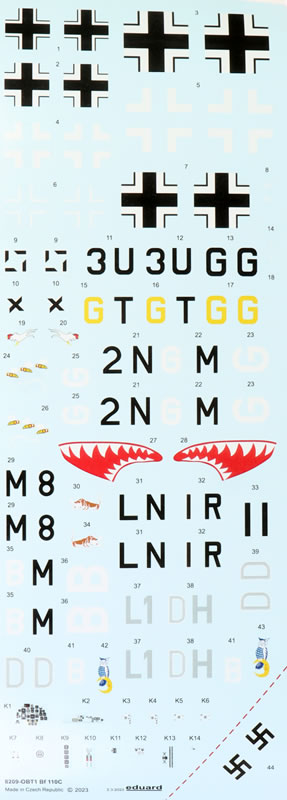
Decals are beautifully printed, with perfect register
and colour saturation.
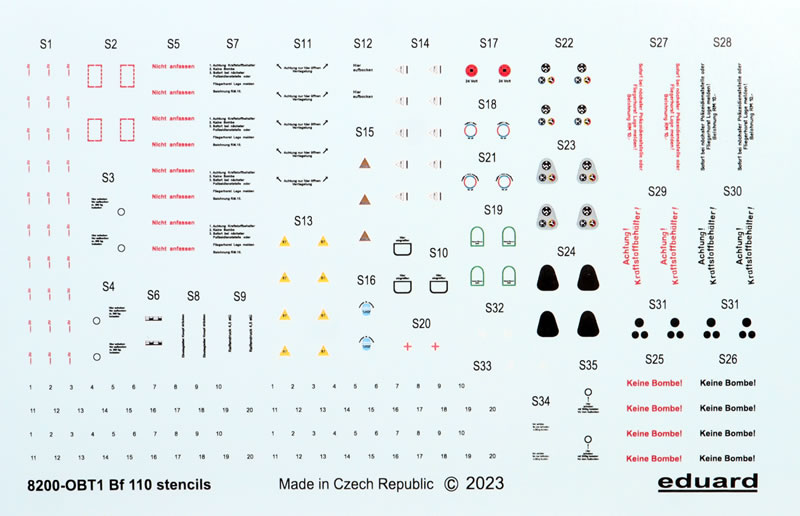
Stencils are offered on a separate decal sheet.
Even after 15 years this is still a nicely presented and detailed kit.
The high parts
count and some of the smaller and delicate parts mean that
modelling experience will be helpful before tackling this project.
Having built the Bf 110 E kit, I can advise that it
is worth the effort. It looks as good when it is finished as it does in the box!
Review Text Copyright © 2023 by
Brett Green
Page Created 6 September, 2023
Last updated 6 September, 2023
Back to HyperScale Main Page
Back to Reviews Page
|
